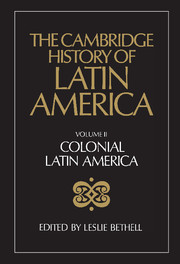Book contents
1 - The population of colonial Spanish America
from PART ONE - POPULATION
Published online by Cambridge University Press: 28 March 2008
Summary
The New World was abundantly peopled when it was first invaded by the Spaniards. Population distribution was, however, uneven, with the heaviest concentrations of people in Mesoamerica and the central Andes, where native American societies had reached the highest levels of economic, social, political and cultural organization. According to circumstances, this distribution of population either helped or hindered the Spanish conquest of America, as it likewise affected Spanish colonization. The presence of a large native American population determined the shape both of the conquest itself and of the colonial structures. They, in their turn, were to influence the process of demographic change. This interaction between population and colonization is the central theme of this chapter, in which the three centuries of Spanish domination have been divided into two. The first part of the chapter deals with the initial sudden and violent clash between invaders and invaded, which was followed by a serious decline in the native American population. The intensity of the demographic catastrophe, and the reasons for it, are discussed. Consideration is also given to the impact of European and African immigration to the New World in the sixteenth and the first half of the seventeenth centuries. The second part examines the way the Indian population slowly recovered, from midway through the colonial period, and the white and mestizo population expanded rapidly, especially in the eighteenth century. The chapter concludes by examining the population of Spanish America, region by region, at the end of the colonial period.
- Type
- Chapter
- Information
- The Cambridge History of Latin America , pp. 1 - 36Publisher: Cambridge University PressPrint publication year: 1984
References
- 3
- Cited by

